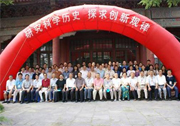| 英文摘要: |
In addition to the traditional method for extracting root with counting rods, there appeared at least two new methods for extraction of root with counting rods in the mathematical books during the period from late Yuan to early Ming dynasties. These methods and the other new methods in mathematical books composed in later period reflect the reform of the methods for extracting root with the counting rods in the context in which abacus was becoming popular. The feature of these methods in common is that all the terms placed with counting rods were never moved back. This is a key step of the transition from the extraction of square root with counting rods to that with abacus.
Among these new methods, the three layers ones with counting rods were more suitable to be reformed into the shangchu method for extracting root with abacus, and this reform happened no later than the first half of 16th century, and maybe even earlier. The guichu method for extracting root is the combination of the guichu division and the shangchu method for extracting root with abacus, which was probably originated in 1560s or 1570s. In term of logic for the development of algorithm, we can summarize the general skeleton of the process in which the method for extracting square root with counting rods was developed into the method for extracting square root with abacus as follows: from the traditional method for extracting root with counting rods to the new methods for extracting root with counting rods, then to the shangchu method for extracting root with abacus, and finally to the guichu method for extracting root with abacus. Furthermore, in view of the situations in which the texts do not mention what calculating tools were used, this paper proposed new accurate standard with which we can distinguish the extraction of root with counting rods from the extraction of root with abacus. |





